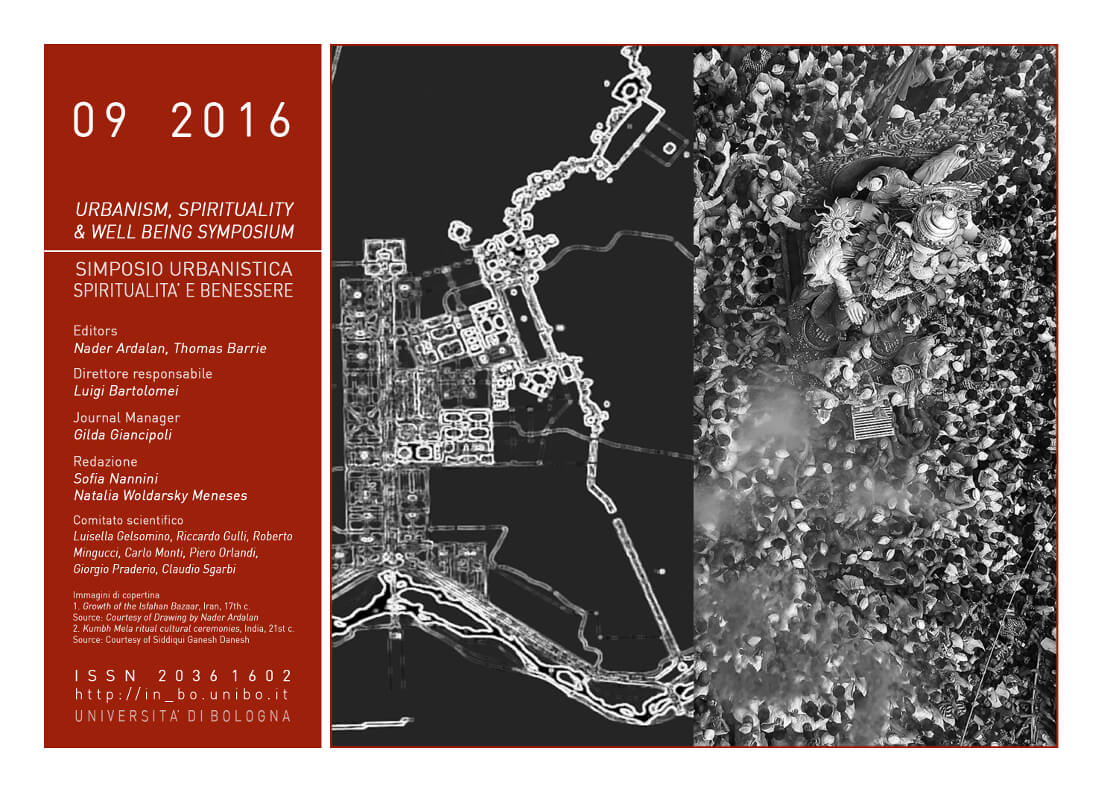The transcendent Dimension of Cities
DOI:
https://doi.org/10.6092/issn.2036-1602/6289Keywords:
Cosmology, Ecology, Metaphysics, Space, TranscendentAbstract
Caught between the past when traditional religious beliefs structured most world views and the current reign of quantity and material consumerism that is threatening the very existence of life on earth, we remain in anxious anticipation of the yet unknown next phase of human consciousness to help mitigate life’s unfolding challenges. Thus, human beings exist in a transitional situation that is precarious and yet full of potential. Within this panorama this paper focuses on two less challenging, yet pivotal questions regarding our urban environments: “What are the transcendent foundations that have given birth and historically sustained great cities of the Middle East over the last ten millennia and what can we learn from them that may inform and influence the holistic transformation and life patterns of our cities today and their future?”References
James Steele, Architecture for the Poor: The Complete Works of Hassan Fathy, Watson-Guptill Press,1997
Jacob Bronowski, The Ascent of Man, Little, Brown & Company, 1973
Jacques Ellul, The Technological Society, Vintage Press, 1964
Ian McHarg, Design with Nature, Natural History Press, 1971
Thomas Berry, The Dream of the Earth, Sierra Club Books, 1990
Abdullah Yusuf Ali, The Holy Quran, Wordsworth Editions, 2001
Ismaiel Bukhari, Sahih al-Bukhari, Dar-us-Salam Publications, 1997
Nader Ardalan, The Spiritual Dimension of Cities, Harvard University Symposium YouTube DVD titled: Urbanism, Spirituality & Well-Being, June, 2013
Paul Wheatley, The Places Where Men Pray Together: Cities in Islamic Lands, Seventh Through the Tenth Centuries, Chicago University Press, 2001
Charles Mann, “The Birth of Religion: The World’s First Temple,” in National Geographic Vol. 219 No. 6, June 2011
Muhammad Al Azraqi, Kitab Akbar Makka: History of Makka, Asadi Library, 2003
Ziauddin Sardar, Mecca: The Sacred City, Bloomsbury USA, 2014
Nader Ardalan, Laleh Bakhtiar, A.C.E, Al Masjid Al Haram: The Extension and Construction of Haram Sharif, Jolly & Barber Ltd. Rugby, UK, 1976
Nader Ardalan, Moshe Safdie, Ralph Barton, Blessed Jerusalem: Preservation Studies of the Visual, Functional and Spiritual Character of the Old City, Harvard University Urban Design Program, 1983
Titus Burckhardt, Fez, City of Islam, Islamic Texts Society, 1992
Nader Ardalan, Laleh Bakhtiar, The Sense of Unity- The Sufi Tradition in Persian Architecture, University of Chicago Press, 1973
Thomas Merton, The New Man, Farrar, Straus & Giroux, 1999
Seyyed Hossein Nasr, Islam in the Modern World: Challenged by the West, Threatened by Fundamentalism, Keeping Faith with Tradition, HarperCollins Press, N.Y, 2010
Laleh Bakhtiar, SUFI, Expressions of the Mystic Quest, Thames and Hudson, London, 1976 and Henry Corbin, Creative Imagination in the Sufism of Ibn Arabi, Routledge and Kagan Paul, London, 1969
Thomas Barrie, Spiritual Path, Sacred Place: Myth Ritual and Meaning in Architecture, Shambala, 1996
Andre Raymond, The Great Arab Cities in the 16th-18th centuries: An Introduction, New York University Press, 1984
Seyyed Hossein Nasr, Introduction to Islamic Cosmological Doctrines, SUNY Press, 1993
Edward O. Wilson, Consilience: The Unity of Knowledge, Vintage Press, 1999
Nicholas Wade, The Faith Instinct: How Religion Evolved and Why It Endures, Penguin Press, 2009
Carl G. Jung, Man and his Symbols, Double Day, NY, 1964
Anat Geva, Frank Lloyd Wright’s Sacred Architecture, Routledge, 2011
Downloads
Published
How to Cite
Issue
Section
License
Copyright (c) 2016 Nader Ardalan
Copyrights and publishing rights of all the texts on this journal belong to the respective authors without restrictions.
This journal is licensed under a Creative Commons Attribution-NonCommercial 4.0 International License (full legal code).
See also our Open Access Policy.
Metadata
All the metadata of the published material is released in the public domain and may be used by anyone free of charge. This includes references.
Metadata — including references — may be re-used in any medium without prior permission for both not-for-profit and for-profit purposes. We kindly ask users to provide a link to the original metadata record.







